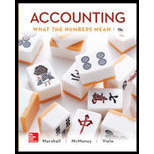
Concept explainers
1.
Concept Introduction:
Variable cost and fixed costs:
Variable costs: The variable costs can be defined as the cost that change directly with the change in the level of output. They are directly related with the level of output. These costs are termed relevant costs as well.
Fixed costs: The fixed costs can be defined as the cost that do not change directly with the change in the level of output. They are not related with the level of output. These costs are termed irrelevant costs generally
Production cost: Production cost refers to the cost which is incurred by the company and is related to the production and manufacturing of services and goods.
Production cost per unit is calculated by dividing production cost with no. of produced units.
To calculate: Variable cost per sweater
2.
Concept Introduction:
Variable cost and fixed costs:
Variable costs: The variable costs can be defined as the cost that change directly with the change in the level of output. They are directly related with the level of output. These costs are termed relevant costs as well.
Fixed costs: The fixed costs can be defined as the cost that do not change directly with the change in the level of output. They are not related with the level of output. These costs are termed irrelevant costs generally
Production cost: Production cost refers to the cost which is incurred by the company and is related to the production and manufacturing of services and goods.
Production cost per unit is calculated by dividing production cost with no. of produced units.
To calculate: The difference of cost of goods sold under variable costing and absorption costing
3.
Concept Introduction:
Variable cost and fixed costs:
Variable costs: The variable costs can be defined as the cost that change directly with the change in the level of output. They are directly related with the level of output. These costs are termed relevant costs as well.
Fixed costs: The fixed costs can be defined as the cost that do not change directly with the change in the level of output. They are not related with the level of output. These costs are termed irrelevant costs generally
Production cost: Production cost refers to the cost which is incurred by the company and is related to the production and manufacturing of services and goods.
Production cost per unit is calculated by dividing production cost with no. of produced units
To express: The sweater cost in a cost formula
Want to see the full answer?
Check out a sample textbook solution
Chapter 13 Solutions
Accounting: What the Numbers Mean
- Can you solve this general accounting problem with appropriate steps and explanations?arrow_forwardI am trying to find the accurate solution to this general accounting problem with the correct explanation.arrow_forward← Week 1: Homework Question 3 of 4 8.75/10 The project is completed in 2025, and a successful patent is obtained. The R&D costs to complete the project are $113,000. The administrative and legal expenses incurred in obtaining patent number 472-1001-84 in 2025 total $16,000. The patent has an expected useful life of 5 years. Record the costs for 2025 in journal entry form. Also, record patent amortization (full year) in 2025. (Credit account titles are automatically indented when amount is entered. Do not indent manually. If no entry is required, select "No Entry" for the account titles and enter O for the amounts. List all debit entries before credit entries.) Account Titles and Explanation Research and Development Expense Cash (To record research and development costs) Patents Cash (To record legal and administrative costs) Amortization Expense Patents (To record one year's amortization expense) Debit 113000 16000 3200 Credit 113000 16000 3200arrow_forward
- Joe transfers land to JH Corporation for 90% of the stock in JH Corporation worth $20,000 plus a note payable to Joe in the amount of $40,000 and the assumption by JH Corporation of a mortgage on the land in the amount of $100,000. The land, which has a basis to Joe of $70,000, is worth $160,000. a. Joe will have a recognized gain on the transfer of $90,000. b. Joe will have a recognized gain on the transfer of $30,000.c. JH Corporation will have a basis in the land transferred by Joe of $70,000. d. JH Corporation will have a basis in the land transferred by Joe of $160,000. e. None of the above.arrow_forwardPlease provide the correct answer to this general accounting problem using accurate calculations.arrow_forwardCan you solve this general accounting question with accurate accounting calculations?arrow_forward

 AccountingAccountingISBN:9781337272094Author:WARREN, Carl S., Reeve, James M., Duchac, Jonathan E.Publisher:Cengage Learning,
AccountingAccountingISBN:9781337272094Author:WARREN, Carl S., Reeve, James M., Duchac, Jonathan E.Publisher:Cengage Learning, Accounting Information SystemsAccountingISBN:9781337619202Author:Hall, James A.Publisher:Cengage Learning,
Accounting Information SystemsAccountingISBN:9781337619202Author:Hall, James A.Publisher:Cengage Learning, Horngren's Cost Accounting: A Managerial Emphasis...AccountingISBN:9780134475585Author:Srikant M. Datar, Madhav V. RajanPublisher:PEARSON
Horngren's Cost Accounting: A Managerial Emphasis...AccountingISBN:9780134475585Author:Srikant M. Datar, Madhav V. RajanPublisher:PEARSON Intermediate AccountingAccountingISBN:9781259722660Author:J. David Spiceland, Mark W. Nelson, Wayne M ThomasPublisher:McGraw-Hill Education
Intermediate AccountingAccountingISBN:9781259722660Author:J. David Spiceland, Mark W. Nelson, Wayne M ThomasPublisher:McGraw-Hill Education Financial and Managerial AccountingAccountingISBN:9781259726705Author:John J Wild, Ken W. Shaw, Barbara Chiappetta Fundamental Accounting PrinciplesPublisher:McGraw-Hill Education
Financial and Managerial AccountingAccountingISBN:9781259726705Author:John J Wild, Ken W. Shaw, Barbara Chiappetta Fundamental Accounting PrinciplesPublisher:McGraw-Hill Education





